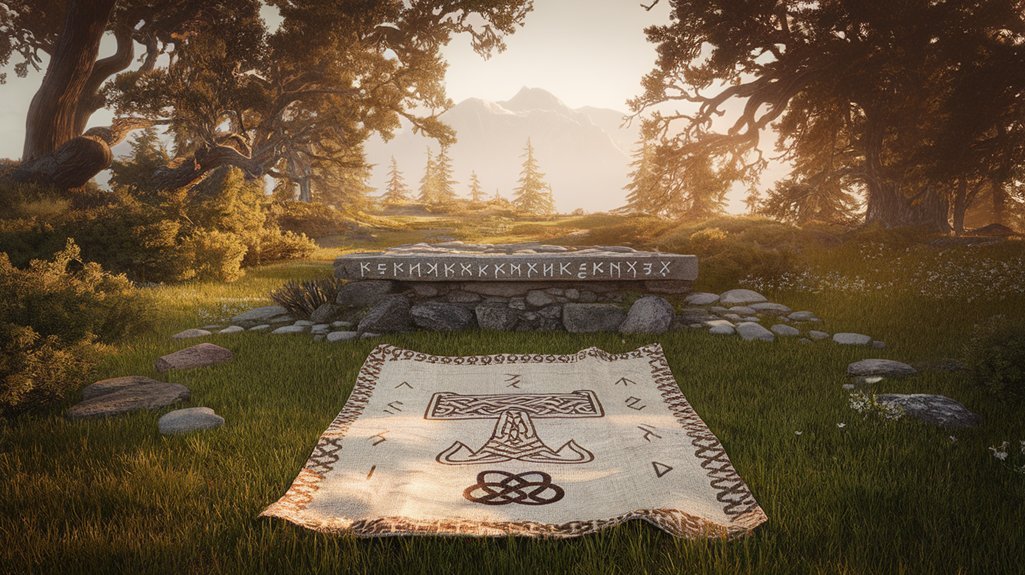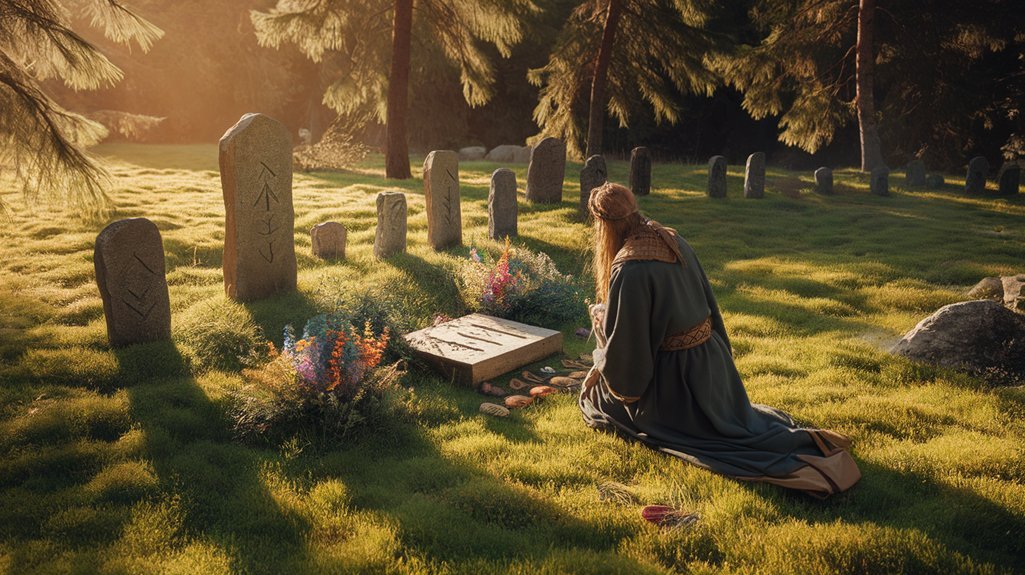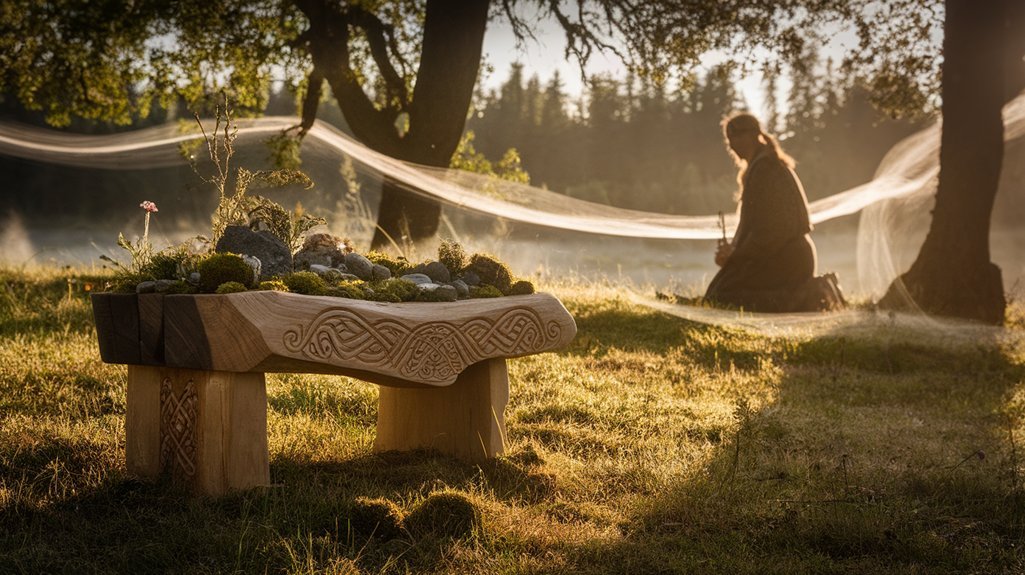As an Amazon Associate I earn from qualifying purchases.
As you explore Asatru and Heathenry, you'll discover a blend of ancient Norse beliefs and modern spiritual practices. These paths offer insight into ancestral reverence, ethical living, and a deep connection with nature. By understanding the role of Norse gods and goddesses, you'll gain a broader perspective on life's challenges and heritage. However, practitioners often face misconceptions, making the exploration of these spiritual paths both intriguing and complex. There's much more to uncover about their contemporary relevance.
Key Takeaways
- Asatru and Heathenry reconnect modern seekers with ancient Norse spiritual traditions through reconstructed rituals and practices.
- Norse deities offer moral guidance and cultural touchstones, enhancing spiritual journeys for modern practitioners.
- Community engagement and nature reverence play vital roles, reflecting interconnectedness in Asatru and Heathenry practices.
- Educational efforts focus on correcting misconceptions and emphasizing cultural appreciation over appropriation.
- Modern interest in Norse spirituality aligns with ecological movements and personal development pursuits.
Origins and Historical Context of Asatru and Heathenry

Although often perceived as modern revivals, Asatru and Heathenry have roots that stretch back to the pre-Christian spiritual traditions of Northern Europe. You'll find that these paths draw heavily from ancient practices of the Norse and Germanic peoples, whose beliefs were deeply intertwined with their daily lives and natural surroundings. By examining archaeological and historical evidence, you can trace how these spiritualities evolved over centuries, influenced by regional variations and societal changes.
In the context of today's cultural revival, Asatru and Heathenry represent a conscious effort to reconnect with these ancient practices. People interested in these paths often seek a deeper understanding of their heritage, using historical texts like the Poetic Edda and archaeological findings to reconstruct rituals and customs. This revival isn't just about imitating the past; it's an ongoing dialogue between ancient wisdom and modern life, where you interpret and adapt historical contexts to contemporary values.
Core Beliefs and Values of Asatru
While Asatru is a modern reconstruction of ancient Norse beliefs, its core tenets offer a profound insight into values that transcend time. At the heart of Asatru lies a deep commitment to sacred duty, a concept that emphasizes living responsibly and honorably. You're encouraged to engage with the world actively, contributing positively to your community and environment. This sense of duty extends to maintaining integrity in all actions.
Ancestral veneration is another pivotal element, where you're called to honor your forebears and learn from their wisdom. This connection to the past fosters a strong sense of identity and continuity. It's not merely about ritualistic remembrance but understanding and appreciating the legacy handed down through generations. Together, sacred duty and ancestral veneration form the ethical backbone of Asatru, guiding adherents in their spiritual and everyday lives while fostering a community centered around shared values and respect.
Understanding the Heathenry Perspective

Delving into the Heathenry perspective provides a nuanced understanding of this belief system's distinctive features and ideological foundations. As you explore Heathenry, it's crucial to recognize the emphasis on personal identity and cultural expressions. Here are four key points to consider:
- Heathenry Identity: It fosters a deep connection with ancestral roots, encouraging you to explore your lineage and heritage.
- Cultural Expressions: This belief system celebrates traditional practices, allowing you to engage in rituals and customs that reflect ancient Norse culture.
- Community and Kinship: Heathenry places significant value on community bonds, urging you to form strong ties with fellow practitioners who share similar values.
- Reconstruction and Interpretation: Modern Heathens often reconstruct ancient practices, balancing historical authenticity with contemporary relevance to make them meaningful today.
The Role of Norse Gods and Goddesses
When exploring the role of Norse gods and goddesses in Asatru and Heathenry, you'll see how these deities significantly influence their followers' lives, offering both guidance and moral frameworks. Each god and goddess embodies specific mythological archetypes and lessons, providing rich narratives that inform personal and communal values. Through rituals and divine connections, practitioners seek to honor these deities, strengthening their spiritual ties and gaining deeper insights into their own existence.
Deities' Influence on Followers
Understanding the influence of Norse deities on their followers requires examining the complex roles these gods and goddesses play in the lives of adherents. Deity worship in modern practices often reflects the personal devotion and spiritual journeys of individuals. Followers experience divine guidance and cultural significance through their interactions with these mythological figures. Here are four key aspects of this dynamic:
- Personal Connection: Followers often feel a personal bond with specific deities, enhancing their spiritual journeys.
- Mythological Influence: The stories of the gods provide lessons and contexts for modern challenges.
- Cultural Significance: Norse deities often serve as cultural touchstones, preserving heritage and tradition.
- Divine Guidance: Many followers seek insight and direction from these deities, shaping their life choices and actions.
Mythological Archetypes and Lessons
The Norse pantheon offers a rich tapestry of mythological archetypes and lessons, each deity embodying distinct virtues and flaws that resonate with followers today. As you explore these mythical heroes, you'll uncover archetypal journeys that mirror human experiences. Odin's relentless quest for knowledge is a transformative myth teaching the value of wisdom, while Thor's bravery in adversity embodies timeless courage. Freyja's duality of love and war provides moral teachings about balance. These deities serve as cultural symbolism, expressing complex character traits that reflect human nature. Their stories impart divine lessons, guiding you through life's challenges with timeless wisdom. By examining these myths, you gain insight into the moral fabric that underpins Norse beliefs, enriching your understanding of human behavior.
Rituals and Divine Connection
How do the rituals practiced by followers of Asatru and Heathenry facilitate a deeper connection with the Norse gods and goddesses? Ritual significance lies at the heart of these practices, serving as conduits for divine communication. By engaging in rituals, you're not only honoring the deities but also cultivating a personal bond with them. Here's how this connection manifests:
- Blót: This sacrificial offering ritual strengthens ties by showing reverence and gratitude to the gods.
- Sumbel: Through toasting and oath-making, you engage in communal divine dialogue.
- Seasonal Festivals: Celebrating natural cycles aligns your life rhythm with the divine.
- Meditative Practices: These facilitate introspection, allowing you to receive guidance and wisdom from the Norse pantheon.
Understanding such rituals enhances your spiritual journey.
Rituals and Practices in Modern Asatru
While exploring modern Asatru, you'll discover that its rituals and practices are deeply rooted in the reverence of Norse deities and the natural world. Central to these practices are seasonal festivals, marking significant points in the year such as solstices and equinoxes. These festivals, like Yule and Ostara, celebrate the cyclical nature of life and honor the gods associated with each season.
Rituals often take place in sacred spaces, which may be outdoors in nature or specially dedicated altars within homes. These spaces serve as a connection point between practitioners and the divine, creating an atmosphere of reverence and focus.
In these rituals, offerings of food, drink, or crafts are made to the gods and ancestors, reflecting gratitude and seeking blessings. These practices emphasize the interconnectedness of all life, encouraging a harmonious relationship with nature and the spiritual world.
Community and Fellowship in Heathenry

Community is a cornerstone of Heathenry, fostering a sense of belonging and shared purpose among its practitioners. As a seeker, you'll find that community gatherings and shared rituals are essential to this practice. Engaging with local clans or joining online networks can provide you with a space to explore inclusive practices and seasonal celebrations. These communal experiences are vital for nurturing a deeper understanding of your beliefs.
Consider these points to deepen your engagement:
- Community Gatherings: Attend events that promote unity and shared experiences.
- Inclusive Practices: Seek groups that welcome diverse voices and foster interfaith dialogues.
- Online Networks: Participate in discussions that transcend geographical boundaries, expanding your perspective.
- Mentorship Opportunities: Look for guidance from experienced practitioners to enhance your journey.
Nature and the Sacred in Norse Spirituality
In Norse spirituality, the natural world is not just a backdrop but a vital component of the sacred experience. You'll find that sacred landscapes hold immense significance, as each geographical feature can embody spiritual power. Mountains, forests, rivers, and other natural formations are seen as living entities, filled with energies that connect you to the divine. These landscapes aren't mere settings; they're active participants in your spiritual journey.
Nature spirits, known as landvættir, play a crucial role in this belief system. They inhabit these sacred landscapes, acting as guardians or messengers between the human and divine realms. Engaging with these spirits requires respect and understanding, as they embody the essence of the land they inhabit. Your interactions with them can deepen your connection to nature, fostering a sense of belonging and reverence. Through this bond, you'll gain insight into the sacredness inherent in the natural world.
Challenges and Misconceptions Faced by Practitioners

Considering the resurgence of Asatru and Heathenry in contemporary society, practitioners often encounter various challenges and misconceptions that can complicate their spiritual journey. You might face cultural appropriation concerns where others misunderstand the revival of these ancient traditions as borrowing rather than reclaiming heritage. Misconceptions within the community itself can also create friction, as differing interpretations of Norse spirituality arise.
To navigate these challenges, consider the following:
- Stereotypes Debunked: Counteract harmful stereotypes by educating others about the true diversity and inclusivity within Heathen practices.
- Community Misconceptions: Engage in open dialogue to address and rectify misunderstandings within your spiritual circles.
- Historical Inaccuracies: Ground your practice in accurate historical contexts to avoid perpetuating myths that distort Norse beliefs.
- Cultural Appropriation Concerns: Clarify the distinction between cultural appreciation and appropriation, emphasizing respect and authenticity.
The Future of Norse Spiritual Paths in the Contemporary World
As you look beyond the challenges and misconceptions, the future of Norse spiritual paths holds significant potential in the contemporary world. With increasing interest in reconnecting with ancestral traditions, practitioners can develop future practices that resonate with modern lifestyles. This evolution often involves adapting ancient teachings into contemporary rituals that maintain authenticity while ensuring relevance.
You might find that integrating technology into practice, such as virtual gatherings or online study groups, can enhance community engagement and accessibility. Additionally, as environmental concerns rise, the emphasis on nature and respect within Norse spirituality can align with broader ecological movements, creating new opportunities for meaningful practice.
Furthermore, as awareness grows, more individuals may seek to explore Norse paths for personal development and spiritual fulfillment. By fostering inclusivity and education, you can contribute to a dynamic, progressive environment that allows these traditions to flourish in a diverse modern landscape.
Frequently Asked Questions
How Do Asatru and Heathenry Differ From Other Pagan Traditions?
You'll notice Asatru and Heathenry emphasize specific Norse deities and traditions, differing from other pagan paths. Ritual practices comparison reveals unique ceremonies, while cultural appropriation concerns arise due to their deep-rooted, culturally-specific origins and symbolism.
Can Anyone Practice Norse Spirituality, or Is It Exclusive to People of Nordic Descent?
Imagine a tree with roots shared by all. You can practice Norse spirituality, but be mindful of cultural appropriation. Embrace inclusive practices, respecting traditions while seeking understanding and connection beyond ancestral lines.
What Role Do Ancestors Play in Asatru and Heathenry?
In Asatru and Heathenry, you'll find that ancestor veneration is crucial. You actively seek ancestral wisdom, honoring your forebears' experiences and insights, which guide your spiritual path and foster a deep connection to your heritage.
Are There Specific Dietary Restrictions in Norse Spiritual Practices?
Imagine a tapestry woven with diversity; Norse spiritual practices don't enforce strict dietary restrictions. Instead, they encourage awareness of traditional dietary customs and ritual feasting, promoting a harmonious balance with nature rather than rigid rules.
How Do Practitioners of Asatru View the Afterlife?
In Asatru, you view the afterlife as diverse spiritual realms. Afterlife beliefs include Valhalla for warriors, Hel for most others, and other realms. Your actions in life influence your journey and destination in these spiritual realms.
Conclusion
As you journey through the realms of Asatru and Heathenry, consider them as a tree with deep roots and ever-expanding branches. The roots symbolize ancestral wisdom, grounding you in traditions and ethics, while the branches represent adaptation and growth in the modern world. By embracing both the ancient and the contemporary, you're nurturing a spiritual ecosystem that fosters resilience and connection. As these paths evolve, they offer you a compass—a guide through the ever-changing landscapes of life.
Amazon and the Amazon logo are trademarks of Amazon.com, Inc, or its affiliates.


